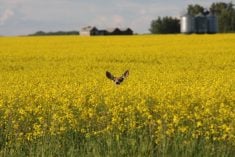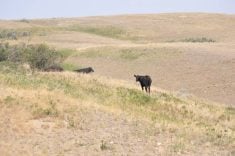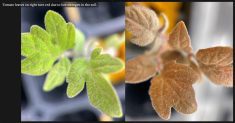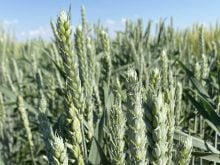One of the advantages of a mixed farm is the opportunity to use crop byproducts as livestock feed. Livestock producers without cropland, however, can often get these same byproducts by working with a grain-farming neighbour.
With uncertain markets and the likelihood of more calves being fed this fall, this kind of co-operation is particularly advantageous.
“Stubble, straw and chaff are the most common crop byproduct and, while they are generally low in protein and energy, they are valuable as an inexpensive source of roughage for cows,” said Allan Foster, a rangeland and forage agrologist with Saskatchewan Agriculture in Tisdale.
Read Also
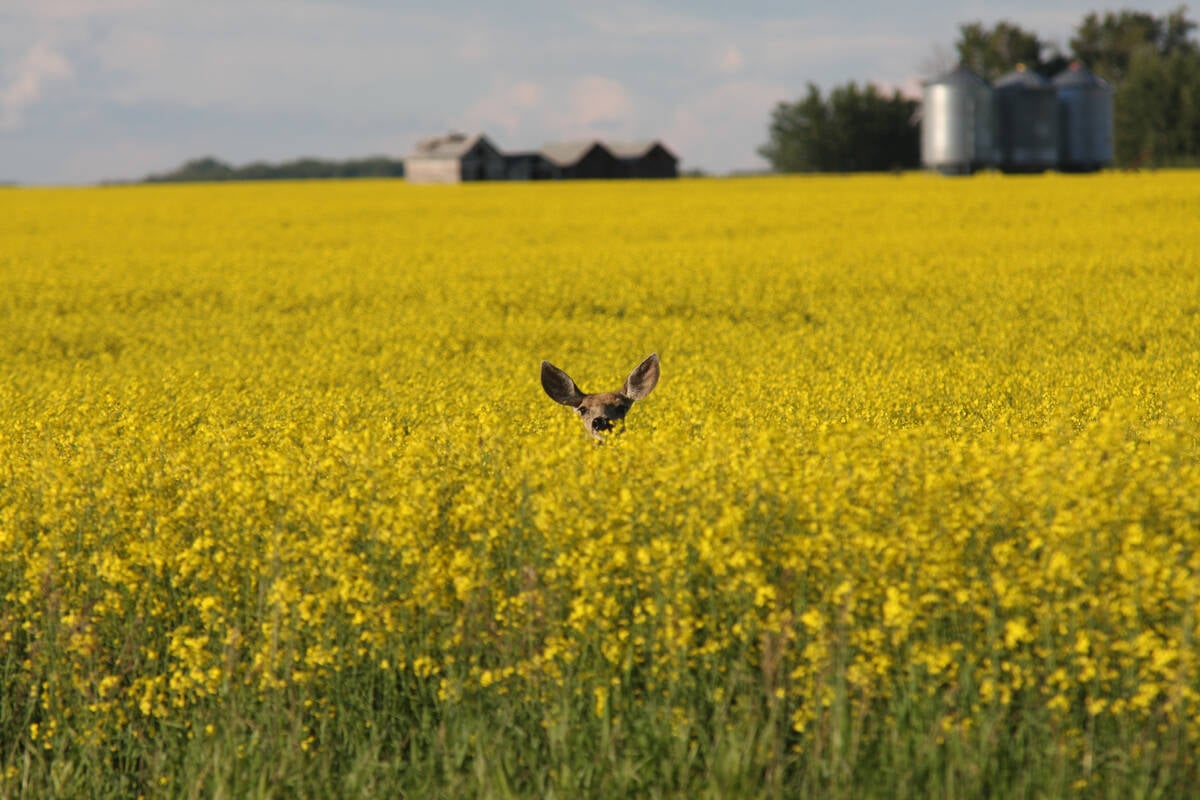
Drones now used to assess wildlife crop damage in Saskatchewan
Wildlife damage in Saskatchewan crops is now assessed by drones and artificial intelligence.
Foster said the feed value of these products depends on the type of crop. For example, based on long-term averages from provincial feed tests, pea straw has six to 71/2 percent protein and 46 percent energy, wheat straw has four percent protein and 42 percent energy, flax straw has three to five percent protein and 40 percent energy and barley straw has four percent protein and 44 percent energy.
“Cereal stubble is often the last pasture used prior to the winter dry lot, and generally it will be higher in quality than the figures cited above because stubble usually contains volunteer cereals and weeds at an immature stage of fall development,” Foster said.
“When grazing stubble, furthermore, cattle often have access to slough fringes, fence lines and other uncultivated ground that contains native or introduced grasses and sedges.”
If these uncultivated areas have been hayed during the year, the quality of the regrowth will be much better than the straw and chaff in the field, Foster said. If the areas contain mature forage, the quality will be lower but still slightly better than that of cereal straw alone.
All cereal straw can be used for wintering the beef herd, but oats and barley straw is often preferred because it is slightly more palatable. All cereal straw has similar nutritional content, so for economic reasons, Foster suggested baling the straw closest to home.
Pea straw, while higher in protein and energy than cereal straw, is less palatable so to encourage cattle to acquire a taste for pea straw, some producers remove all other feed choices for a day or two. Pea straw is difficult to bale because there is no stubble, and it is dustier than most cereal straw because dirt is picked up during harvest.
“One word of caution with the use of any of the straws: do not bale areas that are heavily moulded,” Foster said. “Although most common moulds do not contain any unusual toxins, large amounts of dust or mould can aggravate respiratory problems.”
When fed as rations for beef cows, chaff can be used like straw. Depending on the proportion of grain and weed seeds, its nutritive value can range from slightly better than straw to the equivalent of a low-quality hay.
Chaff may be collected and stored for use as winter feed for confined animals, or it may be left in the stubble fields as piles or windrows that the animals can graze. Leaving chaff in the field for fall grazing eliminates transportation costs and reduces the feeding period in the yard. Chaff and straw also can be ammoniated to improve nutritional value as a cattle feed.
“When cattle are out on stubble late into the season, it is important that they receive supplemental vitamin A and minerals,” he said.
“Because the nutrient content of various types of crop byproducts is variable, in fact, it is a good idea to feed-test to ensure that energy and protein are supplemented to the proper levels. It’s also important that animals always have access to good quality water.”
Cutting attachment
Fecon has a new Bull Hog cutting tool attachment for skid steers with lower lifting capacity.
Weighing 2,250 pounds with a cutting width of 60 inches, the BH74SS has a special narrow cutting tool configuration in the rotor specifically designed for faster cutting with the lower horsepower of skid steers. It cuts brush, trees and stumps down to ground level.
Universal features allow the BH80SS/BH74SS to run on skid steers with 30-46 gpm and 3000-5500 psi hydraulics on the high flow circuit. It works on skid steers with either left or right hand outlets and has a universal mount. Optional trap door and tachometer for the rotor are available on both the BH80SS and the BH80SS/BH74SS.
Common uses include land clearing, right-of-way clearing and maintenance, firebreaks, tree removal and forest management.
For more information, contact Fecon, Inc., 10350 Evendale Dr., Cincinnati, Ohio, 45241, call 800-528-3113, e-mail sales@fecon.com or visit www.fecon.com.
Grain vacs
Brandt has improved its Grain Vac 5000 and Grain Vac 5000 EX.
Both units now have 25 percent greater clean-up capacity, depending on conditions and type of grain, thanks to internal changes in the fan assembly.
Fan components are now boronized for longer life.
The hose tree handles have been improved, the auger tie rods are now one inch and there is a new clean-up shovel.
The Grain Vac 5000 EX has been further enhanced with a complete chrome auger, replaceable drive dogs, double-lipped rubber auger seals, ball bearing flight hangers and a gas shock on the Vac body for easier opening.
For information, contact a Brandt dealer or visit www. brandt.ca.
Insecticide available
Pioneer Hi-Bred will offer the seed-applied insecticides Poncho 250 and Poncho 1250 on selected corn hybrids in 2004.
The seed treatments provide convenient, safe and effective early-season control of soil insects including corn rootworm and secondary insects.
Poncho 250, which contains the new compound clothianidin, is for early-season protection of corn seedlings from only secondary soil insects. The manufacturer Gustafson says Poncho 250 controls seed and seedling damage from black cutworm, wireworm, seed corn maggot, flea beetle and white grub, which is the larvae of the May-June beetle, European chafer and Japanese beetle.
Poncho 1250, the high-rate offering, will be available for growers who have a history of challenges from corn rootworm. According to Gustafson, the rate of clothianidin provided in Poncho 1250 offers control of corn rootworm similar to the control provided by traditional soil-applied insecticides.
For more information, contact a Pioneer retailer.


